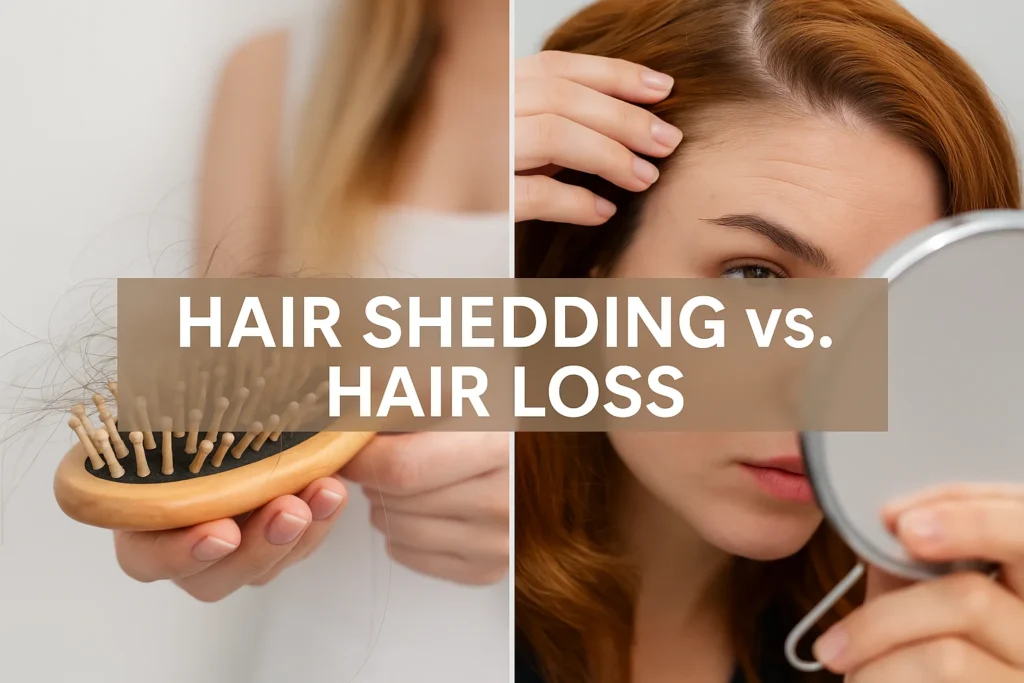How to Tell the Difference | Lushkey’s Zar-E-Gandum Hair Oil
Understanding the difference between hair shedding and hair loss is crucial for maintaining healthy hair and scalp. While both may seem similar at first glance, they arise from different causes and require distinct treatments. If you’re struggling with hair concerns, Lushkey’s Zar-E-Gandum Hair Oil offers a natural, nourishing solution to promote stronger, healthier hair.
Key Differences Between Hair Shedding and Hair Loss
Hair Shedding: A Natural Process
Hair shedding is a normal part of the hair growth cycle. On average, adults shed between 50 to 100 hairs per day. This is a routine turnover that makes room for new, healthy hair growth. Hair shedding usually occurs during the telogen (resting) phase of the hair cycle. Shedding can also be temporary and triggered by stress, illness, hormonal changes, or seasonal transitions.
Signs of Hair Shedding:
- White bulb at the root: A sign that the hair is in the resting phase.
- Normal length and texture: Shed hair matches the appearance of your healthy hair.
- Temporary increase: Shedding may spike after stress, childbirth, or illness but typically resolves within a few weeks to months.
Hair Loss: A Health Concern
Hair loss, on the other hand, refers to a significant reduction in hair density, potentially resulting in bald patches or thinning. Hair loss is more serious and can be caused by underlying health issues, such as nutritional deficiencies, hormonal imbalances, or medical conditions. In contrast to shedding, hair loss can lead to permanent hair thinning or loss, requiring careful attention.
Signs of Hair Loss:
- No white bulb on hair: Hair may fall out without a bulb or break off mid-shaft.
- Thinning or bald spots: This often happens gradually and may not improve over time.
- Scalp sensitivity: Burning, itching, or discomfort can accompany hair loss, signaling a deeper issue.
The Hair Growth Cycle Explained
To understand the difference, it’s important to know how hair grows. The hair growth cycle consists of three phases:
- Anagen (Growth Phase): Lasting 2 to 6 years, this phase is when hair actively grows.
- Catagen (Transition Phase): This brief, 4-week phase marks the end of active growth.
- Telogen (Resting/Shedding Phase): In this 3 to 4-month phase, hair rests before naturally shedding to make room for new growth.
Visual Clues: What Shedding vs. Hair Loss Looks Like
What Hair Shedding Looks Like:
- Hair with a white bulb at the root, indicating it’s naturally shedding.
- No thinning or bald spots on the scalp.
- Temporary increase in shedding after stress or illness.
What Hair Loss Looks Like:
- Short or broken hairs, indicating hair breakage.
- Visible thinning or bald spots, particularly around the temples or crown.
- Gradual thinning with no noticeable regrowth.
Common Situations: Shower Hair, Brush Hair, and More
If you notice extra hair in the shower, on your brush, or on your pillow, it’s often not a cause for concern. However, if you experience significant amounts of hair loss, you should monitor the situation closely.
Shower Hair:
- Normal: A quarter-sized amount (30–100 strands).
- Excessive: Golf ball-sized clumps of hair, especially if it continues daily.
Brush Hair:
- Normal: Up to 50 strands, especially after skipping a day of brushing.
- Excessive: Large tangles or needing to empty the brush daily.
Pillow Hair:
- Normal: A few strands on your pillow.
- Excessive: Clumps of hair or thinning in specific areas.
When to See a Dermatologist or Trichologist
It’s important to seek professional help if:
- Shedding lasts longer than 3 months.
- Visible thinning or bald spots appear.
- Scalp irritation accompanies hair loss, including burning or itching.
Supporting Your Hair Health with Lushkey’s Zar-E-Gandum Hair Oil
Whether you’re dealing with shedding or hair loss, Lushkey’s Zar-E-Gandum Hair Oil can provide nourishment and support for your hair’s natural growth cycle. Packed with natural ingredients, this premium hair oil works to strengthen the hair shaft, reduce hair breakage, and stimulate healthy hair growth. Its restorative properties help combat dryness, brittleness, and dandruff, while promoting a healthier scalp.
Benefits of Zar-E-Gandum Hair Oil:
- Nourishing: Deeply moisturizes hair and scalp to combat dryness.
- Strengthening: Supports the natural hair growth cycle, reducing breakage.
- Soothing: Calms irritation and inflammation of the scalp.
- Promotes Growth: Stimulates blood circulation to hair follicles, encouraging new growth.
FAQs
How do you know if your hair is falling out or shedding?
- Shedding typically has a white bulb at the root and doesn’t cause visible thinning. Hair loss results in thinning or bald spots and lacks regrowth.
Will hair grow back after shedding?
- Yes, hair generally grows back after shedding within 3 to 6 months as long as the follicles are healthy.
What does shed hair look like?
- Shed hair has a white bulb at the root and is smooth and intact with no signs of breakage.
Is the hair shedding cycle the same as the hair loss cycle?
- No. Hair shedding is a natural cycle that leads to regrowth, while hair loss results in permanent thinning or bald spots over time.
Final Thoughts
Understanding the difference between hair shedding and hair loss is key to maintaining healthy hair. While shedding is a natural part of the hair cycle, excessive hair loss requires attention. If you’re concerned about your hair health, Lushkey’s Zar-E-Gandum Hair Oil can be your go-to solution, helping you achieve stronger, healthier hair with continuous care.
For a healthy scalp and beautiful hair, choose Zar-E-Gandum Hair Oil by Lushkey today!




Hi, this is a comment.
To get started with moderating, editing, and deleting comments, please visit the Comments screen in the dashboard.
Commenter avatars come from Gravatar.